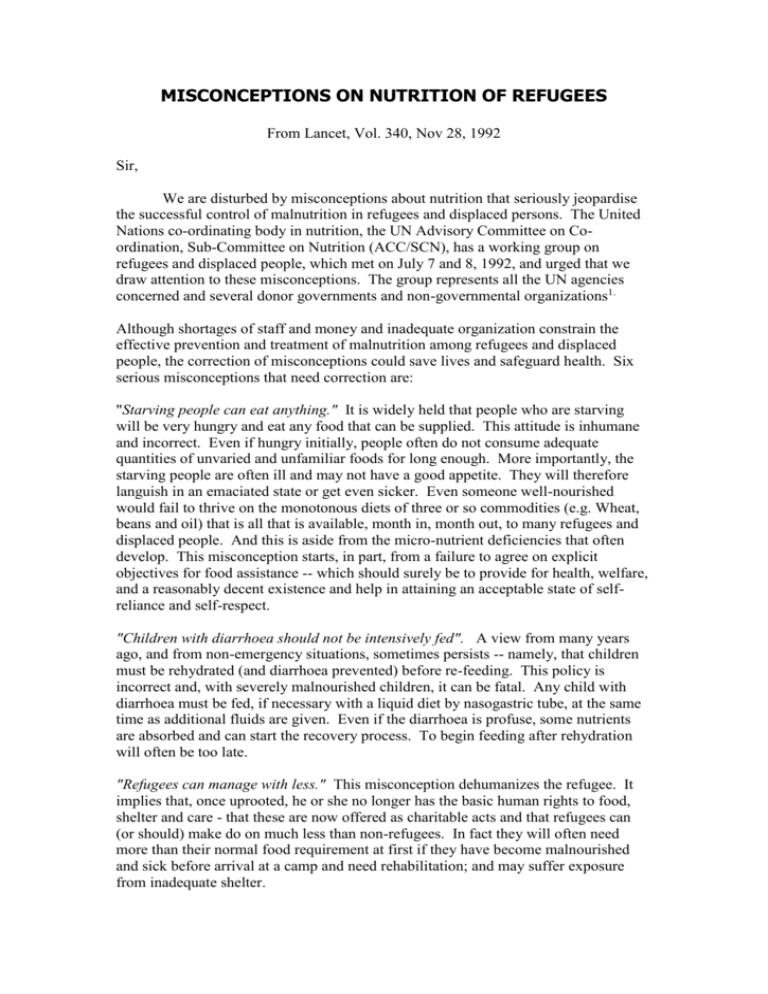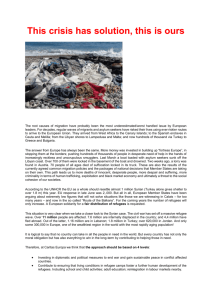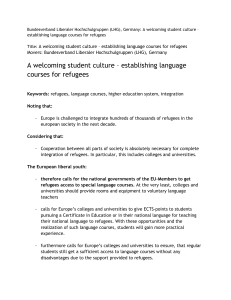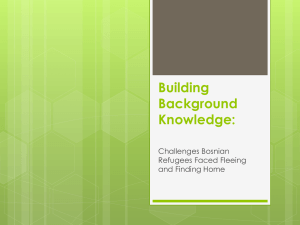misconceptions on nutrition of refugees
advertisement

MISCONCEPTIONS ON NUTRITION OF REFUGEES From Lancet, Vol. 340, Nov 28, 1992 Sir, We are disturbed by misconceptions about nutrition that seriously jeopardise the successful control of malnutrition in refugees and displaced persons. The United Nations co-ordinating body in nutrition, the UN Advisory Committee on Coordination, Sub-Committee on Nutrition (ACC/SCN), has a working group on refugees and displaced people, which met on July 7 and 8, 1992, and urged that we draw attention to these misconceptions. The group represents all the UN agencies concerned and several donor governments and non-governmental organizations1. Although shortages of staff and money and inadequate organization constrain the effective prevention and treatment of malnutrition among refugees and displaced people, the correction of misconceptions could save lives and safeguard health. Six serious misconceptions that need correction are: "Starving people can eat anything." It is widely held that people who are starving will be very hungry and eat any food that can be supplied. This attitude is inhumane and incorrect. Even if hungry initially, people often do not consume adequate quantities of unvaried and unfamiliar foods for long enough. More importantly, the starving people are often ill and may not have a good appetite. They will therefore languish in an emaciated state or get even sicker. Even someone well-nourished would fail to thrive on the monotonous diets of three or so commodities (e.g. Wheat, beans and oil) that is all that is available, month in, month out, to many refugees and displaced people. And this is aside from the micro-nutrient deficiencies that often develop. This misconception starts, in part, from a failure to agree on explicit objectives for food assistance -- which should surely be to provide for health, welfare, and a reasonably decent existence and help in attaining an acceptable state of selfreliance and self-respect. "Children with diarrhoea should not be intensively fed". A view from many years ago, and from non-emergency situations, sometimes persists -- namely, that children must be rehydrated (and diarrhoea prevented) before re-feeding. This policy is incorrect and, with severely malnourished children, it can be fatal. Any child with diarrhoea must be fed, if necessary with a liquid diet by nasogastric tube, at the same time as additional fluids are given. Even if the diarrhoea is profuse, some nutrients are absorbed and can start the recovery process. To begin feeding after rehydration will often be too late. "Refugees can manage with less." This misconception dehumanizes the refugee. It implies that, once uprooted, he or she no longer has the basic human rights to food, shelter and care - that these are now offered as charitable acts and that refugees can (or should) make do on much less than non-refugees. In fact they will often need more than their normal food requirement at first if they have become malnourished and sick before arrival at a camp and need rehabilitation; and may suffer exposure from inadequate shelter. "Trading foods indicates that people do not need all of the rations." If the only food source is provided by camp organizers, these rations have to be adequate in all nutrients. This requires a mixed food basket, including fruits and vegetables. If this cannot be ensured then trading may have to be encouraged if refugees are not to become undernourished and deficient in micro-nutrients. The fact that some foods may be traded, to add variety to the diet, is no grounds for reducing the ration. "A standard ration is suitable for all populations." The recommended per caput calorie output for a refugee population should vary according to demographic composition, nutritional and health status of the population (allowing for an extra "catch-up" allowance where people are malnourished), the activity level the intake is intended to support, environmental temperature, and likely wastage in the chain from supply of food in a country to its consumption by individuals. In other words there is a range of requirements for dietary energy, which will depend on the circumstances, and use of a single figure is likely to lead to either deficit or wastage. The figure of 1900 kcal (commonly assumed to be of general application) often underestimates what is needed. "Energy adequacy means nutritional adequacy." The diet needs to be adequate in both quantity and quality, meeting requirements for calories, protein, and micronutrients. Where refugees are completely dependent on the ration provided -- for example, in the early stages of an emergency or in closed camps, where trading for diversity cannot be ensured -- the ration must be designed to meet the requirements of all nutrients in full. Often, a ration is designed to meet minimum energy requirements and micro-nutrients are left to look after themselves. How micro-nutrient needs are to be met must be made explicit, especially when the ration provided is calculated on the basis of fully meeting energy needs. Foods should be diverse and palatable, and the special needs of weaning children must be met. These and other issues are being addressed in a collaborative inter-agency revision of the 1978 manual The Management of Nutritional Emergencies in Large Populations, to be published soon by WHO. UN ACC Sub-Committee on Nutrition, C/o World Health Organization, 1211 Geneva 27, Switzerland John Mason Stuart Gillespie WHO Nutrition UNIT Graeme Clugston UNICEF Nutrition Cluster Peter Greaves








